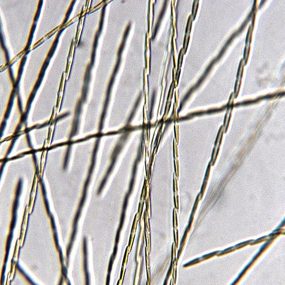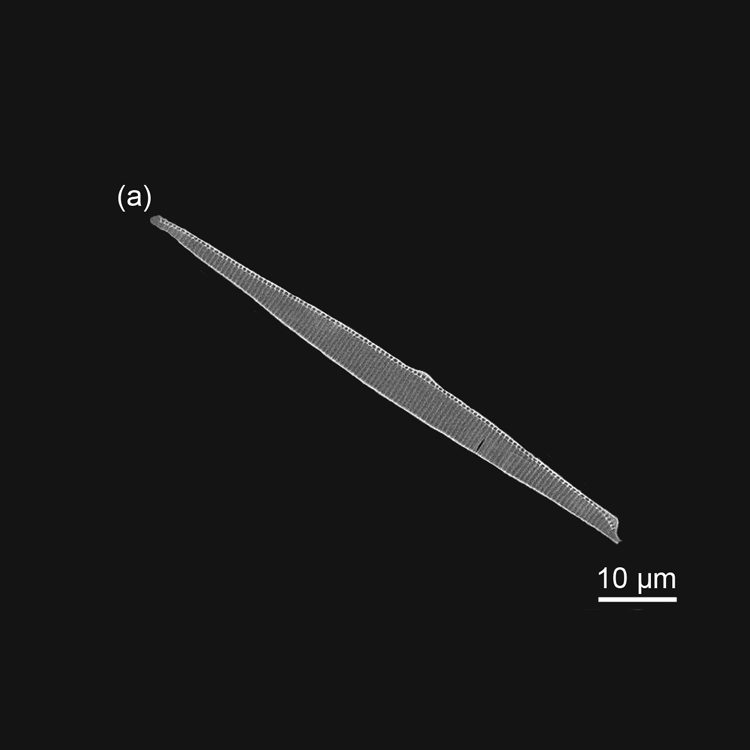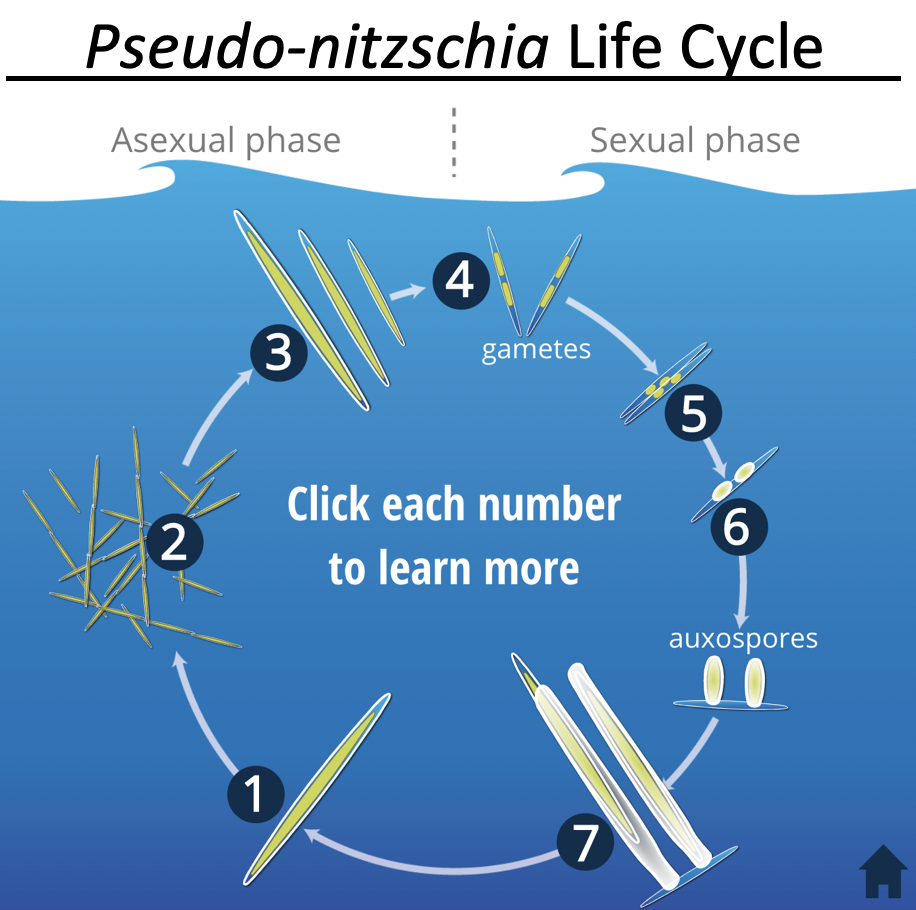
Pseudo-nitzschia
- Produce domoic acid, causing amnesic shellfish poisoning (ASP)
- Both people and wildlife are impacted by ASP
- This is an emerging issue in New England, with the first toxin-related closures occurring in Maine in 2016
- Since then, the region has experienced significant fishery closures and associated toxicity almost annually
- Impacted area in the Northeast: Eastern Maine, Massachusetts, Georges Bank, Rhode Island
What causes ASP and how does it impact people and wildlife?
Amnesic shellfish poisoning (ASP) is an emerging threat in New England which has been the cause of shellfishery closures in recent years. This syndrome is caused by the potent neurotoxin domoic acid, which is produced by diatoms in the genus Pseudo-nitzschia. Domoic acid accumulates in the tissues of organisms that consume toxic Pseudo-nitzschia, such as shellfish and larval fish, and can cause illness in humans and animals who eat the contaminated seafood. Signs of amnesic shellfish poisoning include gastrointestinal distress and neurological symptoms such as headaches, confusion, memory loss, weakness, seizures, and even death. There is no known antidote or cure for ASP, and while recovery is possible, some of the effects of domoic acid in humans can be permanent.
Wildlife also experience the effects of domoic acid poisoning, and Pseudo-nitzschia blooms have been the cause of abnormal behavior and deaths in both mammals and seabirds. Perhaps most notably, Alfred Hitchcock’s iconic movie, “The Birds” was inspired by a real-life event in California when hundreds of strangely behaving seabirds were observed in coastal communities of Monterey Bay. While the cause of this event was unknown at the time, it was later discovered that toxic strains of Pseudo-nitzschia were abundant in the water at the time. More recently, sea lions and other marine mammals in California have made the news for displaying disorientation and other symptoms of sickness. These animals are suffering from the effects of domoic acid toxicosis.
What is the history of ASP in the Northeast?
The first known ASP outbreak was recorded in 1987 in eastern Canada when over one hundred people on Prince Edward Island became ill, and several died, after eating shellfish contaminated with domoic acid. Following this event, Canada implemented a monitoring program and instituted shellfishery closures whenever domoic acid exceeded regulatory limits, effectively preventing further illnesses. While Pseudo-nitzschia have long been present in the Gulf of Maine, no significant blooms or shellfish toxicity were recorded prior to 2012.
In 2012, a precautionary closure was enacted in eastern Maine following the observation of high numbers of Pseudo-nitzschia cells in the water. Additional analysis revealed that domoic acid levels in shellfish were safely below regulatory levels, and the closure measures were lifted although precautionary closures continued in following years. In the fall of 2016, high concentrations of domoic acid in Maine shellfish sparked a public health emergency, causing a shellfish recall and fishery closures over much of Eastern Maine as well as Massachusetts and Rhode Island. At this time, domoic acid levels were measured at over ten times the regulatory limit. Since then, additional closures have been enacted in 2017 in Maine and Rhode Island, and again in Maine in 2018-2019. Pseudo-nitzschia blooms tend to be seasonal, typically occurring in fall or early winter.
How are these events being monitored and managed?
The broad diversity of the Pseudo-nitzschia genus provides a significant challenge for monitoring. There are over 40 known species of Pseudo-nitzschia, and most of these are not easily distinguishable with traditional light microscopy. Molecular methods and electron microscopy are required to obtain definitive identification. Challenges in Pseudo-nitzschia identification are compounded by the fact that multiple species are often found together, and not all species or strains of Pseudo-nitzschia produce domoic acid. A complete understanding of Pseudo-nitzschia communities and their associated toxicity requires a combined microscopy and molecular approach.
Given the emerging nature of ASP in the region, the development and dynamics of Pseudo-nitzschia blooms are poorly understood, although efforts to improve predictive capabilities are currently underway. New remote sensing technologies are being deployed to provide early warnings for blooms. One such instrument is the Environmental Sample Processor (ESP), which can be moored offshore and analyzes water samples for HAB species and their toxins. Another remote instrument, the Imaging FlowCytobot, can collect images of phytoplankton in seawater and transmit them in real time. Together, these instruments provide scientists and managers with the capability to monitor offshore waters for bloom development, and the information that they gather will be used to develop models that can forecast bloom occurrence.
Shellfish toxin testing is a regular part of state monitoring programs across New England, and shellfish from sites along the coastline are regularly tested for domoic acid and other algal toxins. Offshore waters, such as Georges Bank, are federally regulated.
Resources and References
Monitoring
News Articles
- WCAI - Human Health Risks Past, But Shellfish Closures Likely to Linger - Oct. 2016
- NPR - Shellfish Industry, Scientists Wrestle With Potentially Deadly Toxic Algae Bloom - Jan. 2018
- Mount Desert Islander - Shellfish Sampling Ramps Up - Aug. 2019
Research Papers
- Fuentes M.S. and G.H Wikfors. 2013. Control of domoic acid toxin expression in Pseudo-nitzschia multiseries by copper and silica: Relevance to mussel aquaculture in New England (USA). Marine Environmental Research 83(23-28)
- Clark et al. 2019. Pseudo-nitzschia bloom dynamics in the Gulf of Maine: 2012-2016. Harmful Algae 88


